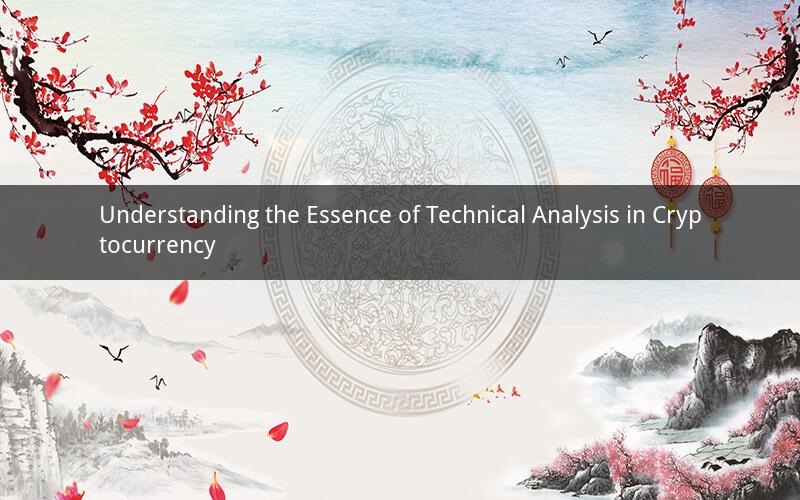
Technical analysis in cryptocurrency is a crucial tool that traders and investors utilize to predict market trends and make informed decisions. By examining historical price movements, technical analysis helps traders understand the potential direction of the market. This article delves into the fundamentals of technical analysis in the crypto space, exploring its principles, tools, and significance.
1. What is technical analysis?
Technical analysis is a method of evaluating assets by analyzing statistics generated by market activity, such as price movement and volume. Traders use technical analysis to identify patterns and trends that can indicate future price movements. The goal is to predict the direction of the market and make profitable trades.
2. Why is technical analysis important in the crypto market?
The crypto market is highly volatile and unpredictable, making it even more crucial for traders to use technical analysis to make informed decisions. Here are a few reasons why technical analysis is important in the crypto market:
- It provides objective data: Technical analysis is based on historical price data, which is objective and not influenced by emotions or opinions.
- It helps identify patterns: By analyzing historical price movements, traders can identify patterns that may repeat in the future, enabling them to make more accurate predictions.
- It provides a framework: Technical analysis provides a structured approach to trading, which can help traders make decisions based on data rather than emotions.
3. Common technical analysis tools and indicators
There are several tools and indicators that traders use in technical analysis. Some of the most popular ones include:
- Moving averages: Moving averages are a simple and popular tool used to identify trends and support/resistance levels.
- Bollinger Bands: Bollinger Bands consist of a middle band being an N-day moving average and two outer bands representing standard deviations from the middle band.
- RSI (Relative Strength Index): RSI is a momentum oscillator that measures the speed and change of price movements.
- MACD (Moving Average Convergence Divergence): MACD is a trend-following momentum indicator that shows the relationship between two moving averages of a security’s price.
4. Common technical analysis patterns
Traders use various technical analysis patterns to predict future price movements. Some of the most common patterns include:
- Head and shoulders: This pattern consists of three peaks, with the middle peak being the highest. It indicates a potential reversal of the current trend.
- Double top and double bottom: These patterns consist of two peaks or valleys, indicating a potential reversal of the current trend.
- Triangles: Triangles are continuation patterns that show a consolidation of prices before a breakout in either direction.
5. The importance of risk management
While technical analysis can provide valuable insights into the market, it is crucial for traders to manage their risk effectively. Here are a few tips for risk management:
- Set stop-loss and take-profit levels: These levels help protect traders from significant losses and lock in profits.
- Diversify your portfolio: By investing in multiple cryptocurrencies, traders can reduce their exposure to the volatility of individual assets.
- Be disciplined: Stick to your trading plan and avoid making impulsive decisions based on emotions.
In conclusion, technical analysis is a valuable tool for traders and investors in the cryptocurrency market. By understanding the principles, tools, and patterns associated with technical analysis, traders can make more informed decisions and potentially increase their profitability. However, it is important to remember that technical analysis is not foolproof, and traders should always be aware of the risks involved.
Questions and Answers:
1. Q: Can technical analysis predict market movements with 100% accuracy?
A: No, technical analysis cannot predict market movements with 100% accuracy. While it can provide valuable insights and patterns, the crypto market is highly volatile and unpredictable.
2. Q: Are there any disadvantages to using technical analysis?
A: One disadvantage of using technical analysis is that it requires a significant amount of time and effort to learn and master. Additionally, it can be challenging to identify patterns in highly volatile markets like cryptocurrency.
3. Q: How can I improve my technical analysis skills?
A: To improve your technical analysis skills, consider the following tips: practice by analyzing historical price charts, study various patterns and indicators, and seek out educational resources and mentors in the field.
4. Q: Should I rely solely on technical analysis for my trading decisions?
A: No, it is not advisable to rely solely on technical analysis for your trading decisions. It is important to complement technical analysis with fundamental analysis, market news, and other relevant factors.
5. Q: Can technical analysis be used for short-term and long-term trading strategies?
A: Yes, technical analysis can be used for both short-term and long-term trading strategies. The key is to choose the appropriate tools and indicators based on your trading time frame and goals.